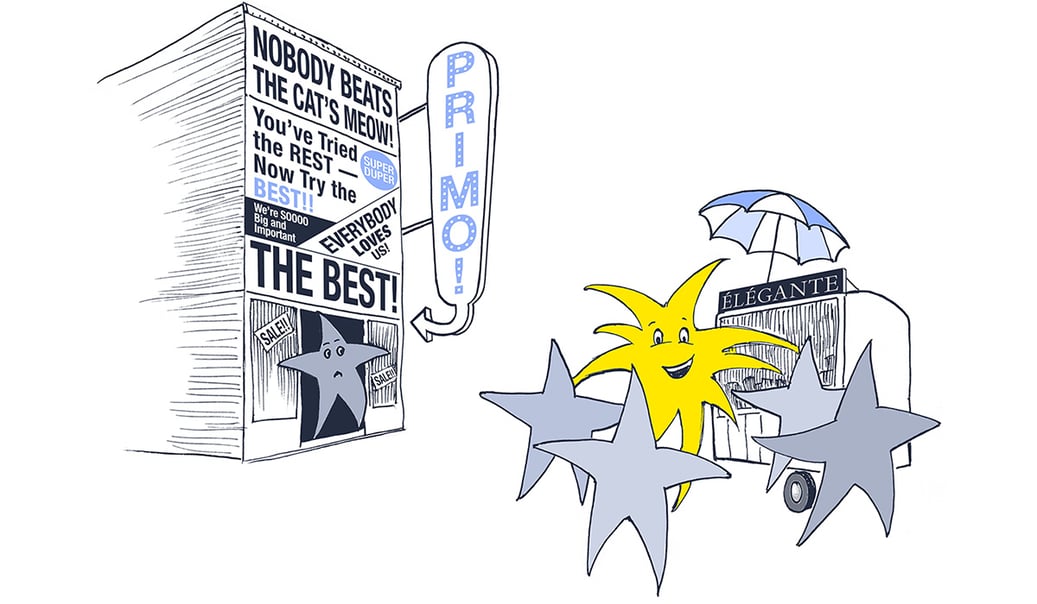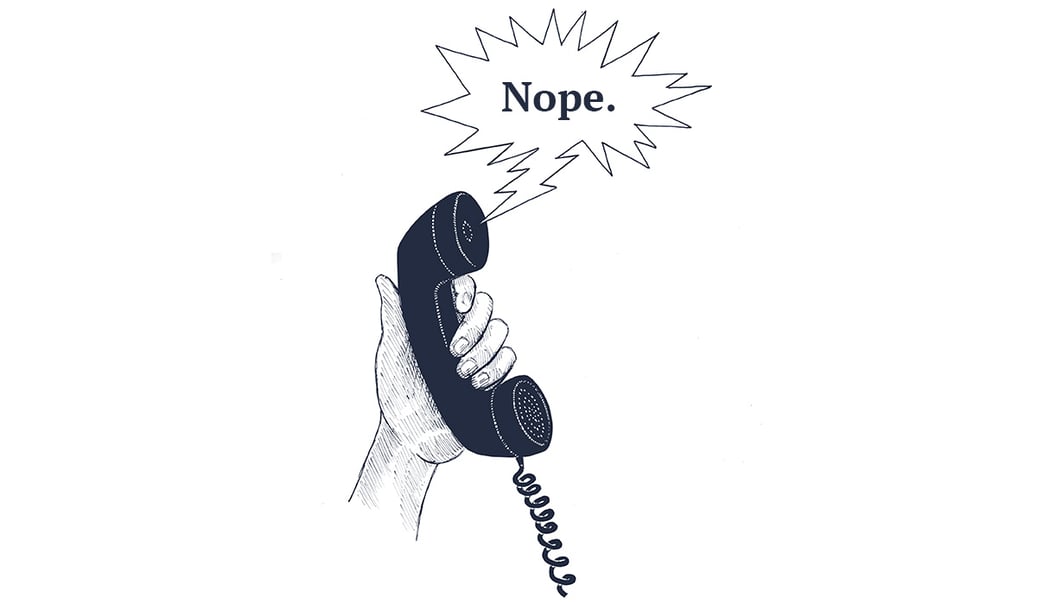When should you say no to a customer?
You see them coming from miles away. You know they're not going to be a good fit for your company. You know they're not going to be happy with your product or service. They are probably going to ask for the good guy discount. These types of customers try to bend your standards — can you make the product custom for the same price as stock? Can you extend special credit terms that you wouldn't otherwise? Perhaps you could consider changing your delivery schedule because they will refer so much more business to you in the future. We all know how these relationships end.
But for some reason, we can't seem to hold ourselves back from entering into lousy customer relationships for the sake of short-term gains. For example, consider a recent car rental experience, where I was not an ideal customer.
It is important to note that I am very loyal to brands. Ask anyone that knows me, and they probably also know my favorite hotel chain, car brand, technology brand, and my preferred car rental company.
I had secured an economy rental car for a business trip. I had no intention of upgrading. My only care was that the vehicle I ended up with was drivable, and I could plug in my cell phone to enable navigation.
As previously established, I am brand-loyal. The car rental company has my history, loyalty number, and preferences on file. Therefore, my car rental transaction should have been a revenue operations symphony. All I needed was to sign and pick up the keys.
Instead of a symphony, imagine an introduction to bagpiping class. The sales staffer insisted this was a good time to upsell me a more fitting ride for my trip. After working the options starting with a luxurious SUV, followed by a midsize SUV and sedan, we ended back at my original reservation — an economy compact car for myself, two pieces of luggage, and my cell phone. And no to all the other extras. What should have been five minutes and future repeat business from a happy customer turned into 35 minutes and a travel-weary, brand-angry customer.
So how do you say no to a less than ideal customer? Step one is to know who your ideal customer is in the first place. Step two, saying no, is made easier if you heed step one.
I’ll walk you through this one-two-step customer dance.

The first rule is to know thy customer.
In addition to knowing your customer, you should also admit that not everyone is your customer. Poorly positioned companies try to be a one-size-fits-all to every opportunity they run across. The consequences of this choice show in customer satisfaction surveys, online reviews, internal morale, and the bottom line. Poorly positioned companies are so worried about making everyone happy that they fall into the category of making no one happy; they are replaceable and commoditized. You're fighting on margin alone. Managing thin margins is not a comfortable place to be if you're concerned about creating a cycle of value for your customers, your employees, and ultimately your company's bottom line.
Well-positioned companies start by knowing their customer. Tightly positioned firms know to go deep within a vertical or a customer profile type to establish themselves with such expertise that they can demand a price premium for that product or service. Steve Jobs probably said it best, “You've got to start with the customer experience and work back toward the technology — not the other way around.” Well-positioned companies are customer-first-oriented, not profit-first-oriented. When employing revenue operations to create value, the company’s customers are the focus, and the profit follows.
So what does a well-positioned customer-first company look like in a traditional industry, such as real estate or building? Let's examine McCarthy Building Companies, established in 1864. This centennial firm believes deeply in creating value for its customers and employees. They state their mission plainly, “to be the best builder in America.” When you have been in business as long as they have, you can make your positioning that lofty. They go further and explain, “It’s our passion for delivering maximum value in commercial construction,” and there you find who they serve — commercial construction. A little more digging into their projects page and you will see the depth and breadth of their positioning. The company's values for green building and community giving are evident in its communications. They talk the talk and walk the walk. Well-positioned companies have that earned luxury.
What if you are not a 158-year-old company? The narrower, the better. You can still set your sights on being the best builder in America. But, like Timothy McCarthy, you may need to narrow by starting niche — McCarthy building companies began as a lumber business in Ann Arbor, Michigan, building farmhouses and barns.
This positioning sounds all well and good, but where do you start? Here are some basic rules and guidelines for addressing your company's positioning.
- Positioning is something that an owner/founder must take the lead on and ultimately decide. That's not to say you can't involve other people, but positioning is a highly personal process and incredible commitment.
- A positioning statement answers succinctly the value you bring as well as the audience served by that value. The narrower both are, the better.
- If you are uneasy about your positioning, you can find easy clues in your existing business. Ask yourself:
- What industry or industries do you serve?
- Are there commonalities or trends between all my customers?
- What are the things that we do well as a business?
- What are the things we have deep expertise in?
- Where do we see the market going?
I highly recommend that if you feel your positioning needs refinement or polishing, as it does every few years or so, to seek out resources or the help of a professional or attend a workshop.

The second rule, please see the first rule.
Knowing the customer was as simple as looking at my previous customer purchase history and account record in my car rental case. Now I can't blame this person for trying to upsell me on a rental car, but he should have taken a hint after the first two tries.
There is nothing more irritating to a customer than a brand acting like they don't know you every time you do business with them. For the sake of this post and my internet connectivity, we will refrain from stories about certain cable and internet providers and their notoriously bad customer service.
It's one thing to “know” your ideal customer as an act of good positioning, with which, by the way, all your communications align. But, it's another thing entirely to “know” your ideal customer, as in name, purchase history, website history, customer preferences, service tickets, etc.
Any tightly aligned technology stack within your company can enable what we call the single source of truth. A technology stack or tech stack is simply all of the technology used to run your company. That technology should help, not hinder, your internal and external processes. This isn't just marketing software or sales software. It includes your phone systems, customer service ticketing system, GPS (to track your customer service vehicles), accounting system, and other back-office functions. A tightly aligned technology stack shouldn't be too tall. All of the technology should be essential to the business and connected so that you have one set of data, the single source of truth. Unfortunately, most of us live in a world with disparate systems that don't talk to each other, run our companies off conflicting data sets, and have no idea how to cost internal efficiencies or attribute true ROI to our efforts.
What does it look like to have a single source of truth? Well, the rental car agent in my case would have had the benefit of my customer record in front of him when I showed up at his counter with the expectation that my preferences would be honored and the key quickly placed in my hand. He would have seen that my recent purchase history shows no upgrades, and all of my preferences were saved to my customer profile. Upon asking him why he was going to all this trouble to upsell me when I already gave him the information he needed on my customer profile, the agent indicated that he didn't have access to my previous purchase history or customer profile. He only had my online order on the screen. Another system was responsible for managing customer profiles and rewards for members.
Instead of a remarkable customer experience, I had a bad experience that has now turned into an article. However, we will leave them nameless for that company’s sake, as I still need to return the car upon publishing this article.
Here are some guidelines for assessing your technology stack in the pursuit of a single source of truth. Ask yourself:
- Is all of our customer data stored in one place? This includes customer profiles, purchase history, digital interactions with your website and other online presences, service tickets, phone calls, etc.
- What systems are essential to each of your departments? Ask each department head to inventory the systems they use and simply how they use them. Is there overlap, or is everyone using an individualized small tech stack in each department?
- Do you have data that supports robust reporting across multiple departments outside of accounting functions? For example, do you have a clearly defined ROI report that shows lead attribution for all of your marketing activities flowing into your sales pipeline with predictive analysis based on close rate and lead value? Does your CRM integrate with your ERP system so that you can follow a lead through to service and beyond?
Suppose the answer is no to the questions above. In that case, probably a good idea to consider doing a technology stack audit to assess the gaps and opportunities for aligning your people and processes with technology. Your customers and bottom line will thank you.

Saying no thank you to less than ideal customers.
This is the easiest part if you have taken the first two steps in this process seriously. Your company is well-positioned. You know who your ideal customer is, and most importantly, your customer knows you know who they are through your highly individualized communications and superior customer service.
And here's the best part, once you have committed to being tightly positioned in the market, you have publicly stated who your ideal customer is. Because of that, you are attracting and retaining more customers who see you as the expert solution to their problems. You created such value for your customers based on your tightly aligned operations that revenue follows.
When revenue follows, saying no is easy. Let's face it. We don't like to say no to potential customers when we face situations that cause your company financial distress. We compromise when we should hold fast.
If you are not the “saying no” type, here are some strategies to let less than ideal prospects know they should move on to another option.
- Create an ideal customer profile page on your website and make it easy to find. Then, when a less-than-ideal prospect reaches out, simply respond with a link that asks them to explore the profile page to see if they see themselves as a good fit. Most will take the hint, especially if the issue is pricing.
- If you are getting a good number of unqualified leads, and if they were larger, either in budget or size of project, etc., that would be a good fit, consider creating a product or bite-size service for a smaller fee that may help them. I would also recommend taking a hard look at your inbound marketing messaging, and outbound marketing audience positioning so that you start getting more qualified leads.
- If you are getting a few unqualified leads and creating a bite-size product or service is not ideal for you, consider finding a referral partner that you can send the business to. This way, you can quickly let the lead know you are not an ideal fit, but you are still providing value by referring them to someone who can help them or to a resource.
- Suppose all else fails, and the lead is like your grandmother, who keeps heaping food on your plate even though you've told her several times you're full. I suggest a simple “thank you, but we are not available at this time” will suffice, or try extremely aggressive pricing if you can’t bring yourself to say no. Every job has its price.
 Illustrations by John Gummere
Illustrations by John Gummere


